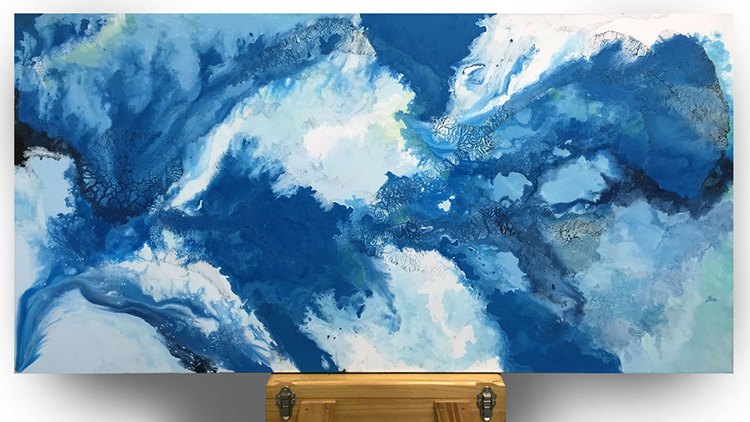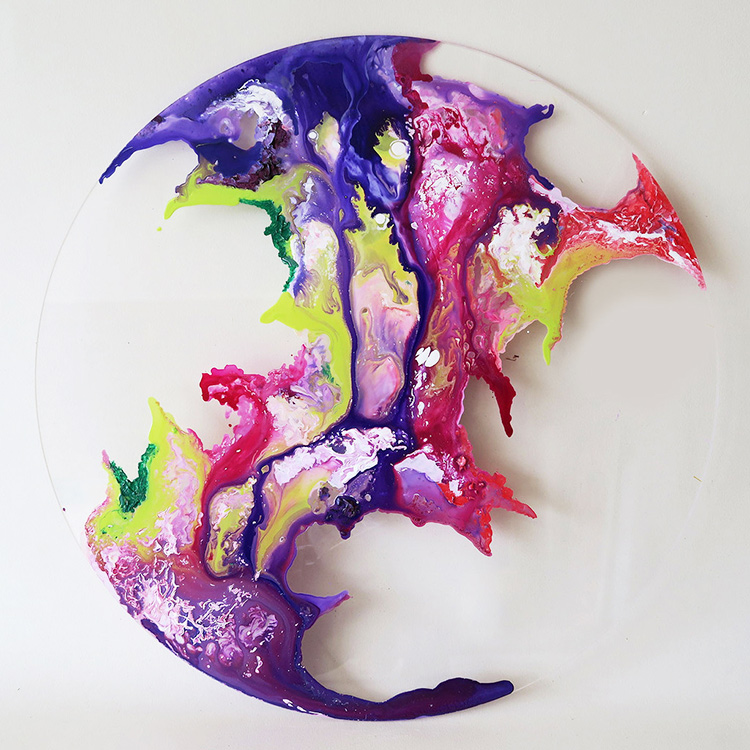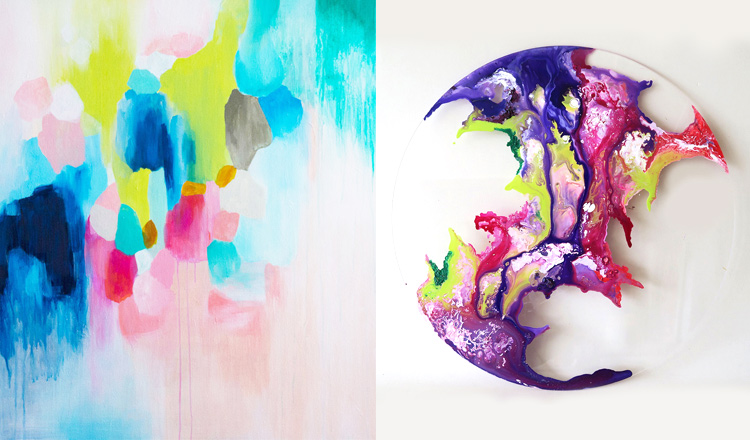Choose an artwork that reflects your style, personality and creates mood with these essential tips…
1. Consider How The Artwork Makes You Feel…
Do you want to be inspired every time you wake up and look at your bedroom wall? Or create a ‘welcoming’ environment in your living room for guests? Perhaps bright colours or abstract prints make you beam with happiness? “A large part of your decision when purchasing artwork should be somewhat based on your instinct and what feels right to you,” explains Chantal. “Ask yourself, does the piece speak to me? How does it make me feel? What does it remind me of? Does it evoke any memories? Once you’ve identified with these thoughts and emotions you then need to consider whether you wish to feel those emotions on a daily basis. Some work can be powerful and thought provoking, which may bring a certain level of intensity into the room. It’s very important to listen to your inner dialogue when considering art – art is subjective after all. If you’re stuck on what subject matter to choose, think about your passions and interests; do you love the blues of the ocean? If so, perhaps find a piece that makes you think of summers at the beach.”

‘Into the Deep: Kali Mera, 2014’, Ruth Crespo Hernandez.
“Do you love animals? A piece from the colourful Animal Kingdom collection by Aidan Weichard might be of preference.”

On the Move, 2015, Aidan Weichard.
“Do you prefer things to be a little different, edgy and quirky? Look for art that’s unique, such as Fi Magee’s invisible canvas.”

The Divine Intervention (Purple), 2015, Fiona Magee.
“Would you prefer art that brings an abstract burst of colour into a room to boost your mood? Ruchi Rai’s gorgeous pieces introduce a lovely balance of colour into a space.”

Aqua Love, 2015, Ruchi Rai.
2. Determine Your Budget
We know you can’t put a price on art but it is important to set a budget. “I always recommend working to a budget,” advises Chantal. “Setting initial parameters will prevent you from making decisions that you may later regret. This way, if you do find a piece that you really love outside of your price range, your budget will force you to seriously consider the purchase before diving in head first. Unless you’re an avid collector, most people would agree that artwork is a luxury that needn’t break your budget. Affordable, original artwork is readily available, you just have to know where to look!”
3. Work Your Champagne Taste On A Beer Budget
Love the Mona Lisa but haven’t got a da Vinci budget? That’s fine – there’s no need to settle for second best, says Chantal. “I have a holistic belief that you should only welcome into your home artwork that you really, truly love,” she explains. “My best budget tip for those interested in original art but don’t want to break the bank, is to purchase paintings or illustrations on paper and get them framed. Artwork by Amber Kingi is fantastic for this. Contemporary, original work for under $290. Artwork should evoke positive emotion every time you look at it, be it sheer admiration for the technical detail or an appreciation for the subject matter or colour palette. If you love a piece enough, there will always be a space in your home for it – no matter how frequently you move!”
4. Choose Art That Reflects Your Personal Style
Self-awareness comes in handy here – how in-touch are you with your emotions? Think about colours you love, feeling, mood and images that inspire you to gauge what’s going to make you happy hanging on your wall. “I have several top tips to help people find artwork that reflects their personal style,” she says. “Magazines, publications and a scrapbook are a great starting point – look through design publications and you’ll find a world of inspiration. Focus on interiors that you admire and look at the artwork they’ve chosen for their home. More often than not you’ll notice that you can bring a wide variety of different styles of work into a space. Scrapbook and document your favourite imagery – over time you will begin to notice a consistent style preference shine through. These images should be your guide when you’re searching for artwork and if you’re still finding it difficult to pull together, invest in a consultation with a decorator or consult your Art Dealer. At Magnus Collective, we offer a consultation service to help people make the right decision for their home.”
Chantal also suggests looking in the mirror. What do you see? “Think about the clothes you wear, do you love textiles and prints? Do you like bold colours or pastels? Do you like natural textures, such as linens and timbers? Are you a monochromatic kind of person or do you prefer a broad spectrum of colours? Then think about the styling of your home and how you might apply your personal taste in artwork to the space.”
5. Think Spatially
You can’t fit a square peg into a round hole – or a life size artwork onto a teeny wall. So how do you determine the right size artwork for the space you have? “Spatial awareness is key,” explains Chantal. “If you have a large wall to fill and you intend on only introducing one piece to that wall – bigger is better. If you’re confident enough to purchase a few pieces and stagger them, then go ahead and purchase multiple smaller works. I have a general rule for a large wall behind a dining or living room sofa which tend to be the most popular places to fill with artwork – always aim for at least 120cm width so it sits in relative proportion to the table or a ‘2-3 seater’ couch. Or, find two pieces of the same size to fit this space. If you can’t find artwork(s) that are the width of the furniture it’s going behind, ensure it’s greater than at least half the width of the furniture in question. When considering the height of the piece – in homes with standard door and ceiling height – try not to hang the piece above the top of the door frame.
6. Just Add Colour
Home decorating shows are a hit for hit reason – creating a colour coordinated and stylish interior space is difficult, especially when you’re inner creative flair is non-existent! But Chantal suggests starting with your existing natural (colour) selection. “We all have personal preferences regarding colour palettes, this is a great place to start,” she advises. “If decorating doesn’t come natural to you, choose furniture with neutral colour palettes and start with a piece of art you absolutely love. Pull one or two accent colours out of that piece and add them elsewhere in the room. Incorporate natural textures such as metals, timbers, stone and flowers to bring warmth and balance into the space.
7. Work With Warm & Cool Colours
Cool interior spaces tend to have more soothing colours – whites, blues, greens, greys, while warmer palettes sway towards earthy browns, reds, oranges and yellows. The rule used to be to stick to one theme – but Chantal is a rule breaker. “Dare to balance warm and cool,” she suggests. “Don’t be afraid to welcome new colours into a space. This can bring a refreshing point of difference that may help you style the room further. For example, if the colour palette of your room in question is warm, balance the space with a cool toned piece of art or vice versa. More often than not, warm and cool colours harmonise.”
8. Mix Your Classics With Contemporary
Just because you have a classic watercolour hanging in one room, does not mean you can’t enjoy modern prints and bold colours in the next room. “Classic and contemporary is a perfect match!” says Chantal. “You can introduce contemporary art into a classic space. If you’re in doubt, Google the homes of some of the most renown Italian Designers and Furniture Designers – arguably some of the most ‘aesthetically aware’ people to grace the planet. Introducing contemporary art to a classic space will give your home the lift it needs to ensure it doesn’t look tired and dated. You can also introduce classical art, such as renaissance style to a contemporary space.” But Chantal warns against creating too much noise. “If you love a geometric print, or fabrics with bold textiles, you don’t need to necessarily replicate this in the artwork you choose. Artwork might be an opportunity to calm the space down and create quieter moments.”
MagnusCollective.com.au is an online art gallery who offers affordable, original artwork by emerging artists, unveiling new artistic talent, promoting visual ideas and selling original works of art.










